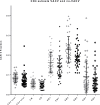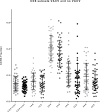Long-term effects of smallpox vaccination on expression of the HIV-1 co-receptor CCR5 in women
- PMID: 30440008
- PMCID: PMC6237380
- DOI: 10.1371/journal.pone.0207259
Long-term effects of smallpox vaccination on expression of the HIV-1 co-receptor CCR5 in women
Abstract
Background: Smallpox vaccinations were stopped globally in 1980. Recent studies have shown that in women, being smallpox vaccinated was associated with a reduced risk of HIV infection compared with not being smallpox vaccinated. At the initial infection, HIV-1 most often uses CCR5 as a co-receptor to infect the T-lymphocytes. We therefore investigated whether smallpox vaccination is associated with a down-regulation of CCR5 on the surface of peripheral T-lymphocytes in healthy women in Guinea-Bissau.
Methods: We included HIV seronegative women from Bissau, Guinea-Bissau, born before 1974, with and without a smallpox vaccination scar. Blood samples were stabilised in a TransFix buffer solution and stained for flow cytometry according to a T-cell maturation profile.
Results: Ninety-seven women were included in the study; 52 with a smallpox vaccination scar and 45 without a scar. No association between smallpox vaccination scar and CCR5 expression was found in any T-lymphocyte subtype.
Conclusion: Among HIV seronegative women, being smallpox vaccinated more than 40 years ago was not associated with a down-regulation of CCR5 receptors on the surface of peripheral T-lymphocytes.
Conflict of interest statement
The authors have declared that no competing interests exist.
Figures






Similar articles
-
Phase-out of smallpox vaccination and the female/male HIV-1 prevalence ratio: an ecological study from Guinea-Bissau.BMJ Open. 2019 Oct 30;9(10):e031415. doi: 10.1136/bmjopen-2019-031415. BMJ Open. 2019. PMID: 31666269 Free PMC article.
-
Downregulation of CCR5 on activated CD4 T cells in HIV-infected Indians.J Clin Virol. 2008 Sep;43(1):25-31. doi: 10.1016/j.jcv.2008.03.026. Epub 2008 May 6. J Clin Virol. 2008. PMID: 18462992
-
CCR5 expression, haplotype and immune activation in protection from infection in HIV-exposed uninfected individuals in HIV-serodiscordant relationships.Immunology. 2017 Aug;151(4):464-473. doi: 10.1111/imm.12743. Epub 2017 May 24. Immunology. 2017. PMID: 28398593 Free PMC article.
-
The number of CCR5 expressing CD4+ T lymphocytes is lower in HIV-infected long-term non-progressors with viral control compared to normal progressors: a cross-sectional study.BMC Infect Dis. 2014 Dec 13;14:683. doi: 10.1186/s12879-014-0683-0. BMC Infect Dis. 2014. PMID: 25495598 Free PMC article.
-
[Deep lung--cellular reaction to HIV].Rev Port Pneumol. 2007 Mar-Apr;13(2):175-212. Rev Port Pneumol. 2007. PMID: 17492233 Review. Portuguese.
Cited by
-
Heterologous Immunity: Role in Natural and Vaccine-Induced Resistance to Infections.Front Immunol. 2019 Nov 8;10:2631. doi: 10.3389/fimmu.2019.02631. eCollection 2019. Front Immunol. 2019. PMID: 31781118 Free PMC article. Review.
-
Phase-out of smallpox vaccination and the female/male HIV-1 prevalence ratio: an ecological study from Guinea-Bissau.BMJ Open. 2019 Oct 30;9(10):e031415. doi: 10.1136/bmjopen-2019-031415. BMJ Open. 2019. PMID: 31666269 Free PMC article.
References
-
- Huang Y, Paxton WA, Wolinsky SM, Neumann AU, Zhang L, He T, et al. The role of a mutant CCR5 allele in HIV-1 transmission and disease progression. Nature medicine. 1996;2(11):1240–3. . - PubMed
-
- Symons J, Vandekerckhove L, Hutter G, Wensing AM, van Ham PM, Deeks SG, et al. Dependence on the CCR5 coreceptor for viral replication explains the lack of rebound of CXCR4-predicted HIV variants in the Berlin patient. Clinical infectious diseases: an official publication of the Infectious Diseases Society of America. 2014;59(4):596–600. 10.1093/cid/ciu284 . - DOI - PMC - PubMed
-
- Hutter G, Nowak D, Mossner M, Ganepola S, Mussig A, Allers K, et al. Long-term control of HIV by CCR5 Delta32/Delta32 stem-cell transplantation. The New England journal of medicine. 2009;360(7):692–8. 10.1056/NEJMoa0802905 . - DOI - PubMed
-
- Ennis FA, Cruz J, Demkowicz WE Jr., Rothman AL, McClain DJ. Primary induction of human CD8+ cytotoxic T lymphocytes and interferon-gamma-producing T cells after smallpox vaccination. J Infect Dis. 2002;185(11):1657–9. 10.1086/340517 . - DOI - PubMed
Publication types
MeSH terms
Substances
LinkOut - more resources
Full Text Sources
Medical

